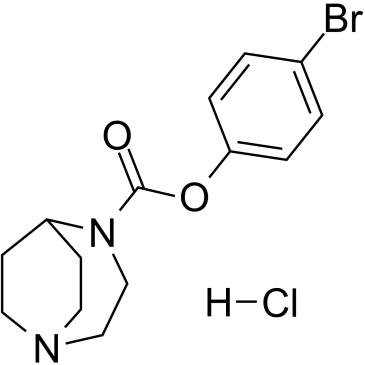SSR 180711 hydrochloride
Modify Date: 2025-08-26 13:52:20

SSR 180711 hydrochloride structure
|
Common Name | SSR 180711 hydrochloride | ||
|---|---|---|---|---|
| CAS Number | 446031-79-4 | Molecular Weight | 361.66 | |
| Density | N/A | Boiling Point | N/A | |
| Molecular Formula | C14H18BrClN2O2 | Melting Point | N/A | |
| MSDS | N/A | Flash Point | N/A | |
Use of SSR 180711 hydrochlorideSSR180711 hydrochloride is an orally active, selective and reversible α7 acetylcholine nicotinic receptor (n-AChRs) partial agonist. SSR180711 hydrochloride can act on rat α7 n-AChR (Ki=22 nM; IC50=30 nM) and human α7 n-AChR (Ki=14 nM; IC50=18 nM). SSR180711 hydrochloride increases glutamatergic neurotransmission, ACh release and long-term potentiation (LTP) in the hippocampus[1]. |
| Name | SSR180711 hydrochloride |
|---|
| Description | SSR180711 hydrochloride is an orally active, selective and reversible α7 acetylcholine nicotinic receptor (n-AChRs) partial agonist. SSR180711 hydrochloride can act on rat α7 n-AChR (Ki=22 nM; IC50=30 nM) and human α7 n-AChR (Ki=14 nM; IC50=18 nM). SSR180711 hydrochloride increases glutamatergic neurotransmission, ACh release and long-term potentiation (LTP) in the hippocampus[1]. |
|---|---|
| Related Catalog | |
| Target |
IC50: 30 nM (rat α7 n-AChR) and 18 nM (human α7 n-AChR)[1] Ki: 22 nM (rat α7 n-AChR) and 14 µM (human α7 n-AChR)[1] |
| In Vitro | SSR180711 hydrochloride is selective for the α7 receptor subtype compared to α4β2, α3β2, α3β4, and α1β1γδ human n-AChR subtypes (IC50>5 μM). SSR180711 hydrochloride (10 μM) has no inhibition (lower than 50%) for the ionic channels, neurotransmitter, or peptide receptors[1]. SSR180711 hydrochloride (0.01-10000 μM) is a potent partial agonist at human α7 n-AChRs expressed in Xenopus oocytes or GH4C1 cells and elicits typical concentration-dependent inward currents with an EC50 value of 4.4 μM (2.5-7.8 μM)[1]. |
| In Vivo | SSR180711 hydrochloride rapidly penetrates into the brain (ID50=8 mg/kg; p.o.). SSR180711 hydrochloride dose-dependently inhibits the specific [3H]α-BTX binding in the mouse brain (ID50=8.3 and 7.5 mg/kg for p.o. and i.p., respectively)[1]. SSR180711 hydrochloride (1-10 mg/kg for i.p.; 10-30 mg/kg for p.o.) dose-dependently increases extracellular acetylcholine (ACh) levels in the hippocampus and prefrontal cortex of freely moving rats[1]. SSR180711 hydrochloride (0.1, 0.3, 1 mg/kg; i.v.) dose-dependently increases firing rate[1]. |
| References |
| Molecular Formula | C14H18BrClN2O2 |
|---|---|
| Molecular Weight | 361.66 |
| InChIKey | YNBXNVUZXFMNSJ-UHFFFAOYSA-N |
| SMILES | Cl.O=C(Oc1ccc(Br)cc1)N1CCN2CCC1CC2 |